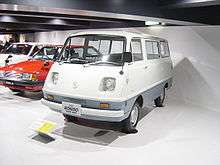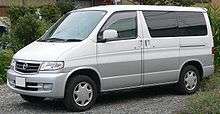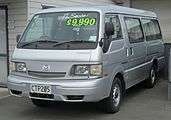Mazda Bongo
| Mazda Bongo | |
|---|---|
|
| |
| Overview | |
| Manufacturer | Mazda |
| Also called |
Mazda E-Series Mazda Access Ford Econovan Mazda Marathon |
| Production | 1966–present |
| Assembly |
Japan: Mazda Hiroshima Plant Malaysia: Shah Alam (AMI)[1] Zimbabwe: Willowvale (WMMI) |
| Body and chassis | |
| Class | Van |
| Related | Kia Bongo |
The Mazda Bongo, also known as Mazda E-Series, Mazda Access, and the Ford Econovan, is a van manufactured by the Japanese manufacturer Mazda since 1966. It has been built with rear-, middle-, as well as front-mounted engines. It also formed the basis for the long running Kia Bongo range.
First generation (1966–1975)

Mazda introduced its small van, the Bongo, in May 1966. It featured a rear-mounted 782 cc water-cooled OHV SA 4-stroke engine driving the rear wheels. The rear-engined Bongo was produced in two versions from 1968, as the F800 was joined by the bigger-engined F1000. This has a 987 cc PB overhead valve inline-four engine with 48 PS (35 kW) at 5500 rpm.[2] The chassis code for the 1-litre model is FPA. Mazda also showed an electrically powered version of the van, which could reach 75 km/h (47 mph) and with a 60 km (37 mi) range.[2] This remained a prototype. The engines were shared with Mazda's Familia small car range. Production ended in 1975, due to Mazda suffering serious economic troubles and upcoming stricter emissions regulations for 1976. This model retained the same body shape for its 10-year production life, the later models fitted with inertia-reel seat belts, and separate front parking indicator lights.
The rear-engined Bongos had a full chassis (using the same Mazda 1000 engine as other variants mounted to a four-speed transaxle at the rear) and were very strong and due to the low gearing, able to carry half a ton. Due to rust and poor maintenance, these Bongos are now rare. The 1000 pickup and Bongo chassis are different, with common front suspension and brake components.
Second generation (1977–1983)
_01.jpg)
The next Bongo van appeared in September 1977. It was a mid-engine rear wheel drive vehicle. Ford sold this version of the van as the Ford Econovan, while Mazda sold it for export as the E1300, E1400, and E1600, depending on engine size. Beginning in February 1980 a 2.2-litre diesel engine was also available, sold in export as the E2200.[3] This generation was also manufactured by Kia in South Korea, as the Kia Bongo and Ceres. The Bongo/Ceres underwent a number of facelifts and was still available as late as 1999. As the E1600, this model went on sale in Great Britain in 1982, only a year before being replaced. The British market only received the long wheelbase 1-tonne panel van version with small, twinned rear wheels. The UK model has a five-speed manual gearbox with a column mounted shifter.[4]
The original version has round headlights and no grille; after a facelift the second generation Bongo/E-series had rectangular headlights and a more traditional grille. This took place in January 1981.[3]
In Australia, rebadged versions were sold as the Ford Econovan as a SWB petrol van (with and without side windows), LWB petrol van (with and without side windows), and LWB diesel van guises (windowless). SWB and LWB window petrol vans also sold in passenger-carrying Ford Econowagon form.[5] Luxury-oriented passenger models were sold under the Ford Spectron name as high-roof eight-seaters.[6]
Engines
- 1977–1979 1272 cc TC, 60 PS (44 kW) / 77 PS (57 kW) JIS (Japan) – BA2T8
- 1978–1982 1586 cc NA, 80 PS (59 kW) / 82 PS (60 kW) JIS (Japan) – BA2N9
- 1979–1980 1415 cc UC, 70 PS (52 kW)
- February 1980–198? 2209 cc S2, 66 PS (49 kW)
Third generation (1983–1999)
_E2000_IMG_0258.jpg)
The Bongo was redesigned in 1983 with new engines. It was also sold by Ford in Asia as the "Spectron" (passenger version) or as the "J80" (cargo model). In Australia, the Bongo was sold by Mazda as the E-series, with Ford also retailing the commercial version as the "Ford Econovan" and the passenger version as the "Ford Spectron" (1983–1990). From 1994 onwards, the Bongo was also sold by Nissan as the Vanette. In South Korea this was built as the Kia Wide Bongo.
- Australia
In Australia, it was sold as the Mazda E-series and also as the Ford Econovan and Ford Spectron. The entry-level Econovan offered a 4-metre (13.1 ft) length, 1.8-litre petrol engine, five-speed manual of four-speed automatic, single rear wheels, in three-seater steel-sided or six seater XL window-sided forms.[7] Prior to 1986, there was also a 1.4-litre engine and five-speed manual option available as a steel-sided van with single- or dual-rear wheels, and as a passenger-carrying XL van with single-rear wheels.[8][9]
The 4.4-metre (14.4 ft) long Econovan Maxi offered a high roof, 2.0-litre petrol engine with five-speed manual of four-speed automatic, single rear wheels, and three-seater steel-sided or six seater XL window-sided forms.[7] Dual rear wheels were available for the 2.0-litre petrol or a 2.2-litre diesel, both with five-speed manual and as steel-sided vans.[7]
The 4.7-metre (15.4 ft) long Econovan Maxi van was also high roofed, but steel-sided only.[7] Powertrain and rear wheel setups were the same as the 4.4-metre Maxi.[7] In 1986, four-wheel drive became an option for the 4.7-metre long model in conjunction with the windowed body work, manual transmission, and 2.0-litre engine.[10] A cab chassis version was offered on the 4.7-metre chassis, with 2.0-litre petrol engine with five-speed manual.[7] It was available as a two-door, three-seater model with 1.5-tonne (3,300 lb) payload and as a four-door, six-seater "Crew Cab" with 1.4-tonne (3,100 lb) payload.[7]
In December 1985, Ford updated the Econovan in Australia to upgrade the engines for unleaded petrol.[11] The petrol engine fitted to 4.0-metre Econovan increased in displacement from 1.4 to 1.8 litres, and the 4.4-metre Maxi had its petrol engine increased from 1.8 to 2.0 litres.[11] The 4.0- and 4.4-metre Econovan also gained the availability of four-speed automatic, previously fitted only to the Spectron vans.[11] The 4.7-metre Maxi van, previously available only with dual rear wheels, was now also available with single rear wheels, although crew cab and cab chassis models remained as dual rear wheel propositions.[11] Ford stated that all petrol manuals and the 4.4-metre petrol automatic Maxi were designed to run on both leaded and unleaded fuel, although the 4.0-metre petrol automatic will run only on unleaded.[11] At the same time as these powertrain updates, Ford also made some cosmetic changes to the Spectron.[11] The low-roof Spectron added colour-keyed bumpers and a new side stripe, matched to a new beige cloth interior trim, and on the XLT the old beige interior colour switched to grey.[11]
Engines
Petrol
Diesel
|
Bongo Brawny
A new long-wheelbase version known as the Bongo Brawny was also introduced, three months before the regular Bongo. The Brawny was larger than the regular Bongo in by all key measures (wheelbase, length, width, height, and weight). In export markets this model was again sold as the E-series. In Australia, Ford differentiated the long-wheelbase versions with the "Econovan Maxi" identifier.
|
Fourth generation (SK/SL; 1999–present)


In June 1999, a new generation of Bongo vans and trucks went on sale, which were also rebadged as the Mazda E-series, Ford Econovan, Mitsubishi Delica, and Nissan Vanette. This model adopted the SK platform which is based on previous generation SS/SE model. Mazda's difficult management environment at that time meant they could not afford to build a full brand new platform. Petrol 1.8L EGI F8-E(90ps) and Diesel 2.2L R2(79ps) were available.
- Nov. 1999 Rebadging model Mitsubishi Delica released in Japan only.
- Dec. 2003 Minor change new common rail direct fuel injection diesel model introduced.
- Nov. 2005 Minor updated for exterior lighting.
- 2006 E1800(SKW0) for Australia market discontinued.
- Aug. 2007 DPF introduced for diesel engine models. Power windows and central locking for all truck model.
- May. 2009 Stop the supply 2WD petrol models for Nissan. Due to Nissan introduced in-house designed NV200 Vanette.
- Aug. 2010 Minor updated for entire range. Introduced new 1.8 Petrol engine L8, Large center console box due to this reduced seating capacity and new model codes SKP2T/SKP2L applied.
- 2011 E1800(SKW0) for New Zealand market discontinued.
- Oct. 2011 Rebadging model Mitsubishi Delica discontinued. Delica shifted rebadging of Nissan NV200 Vanette.
- Mar. 2012 Mazda announced that this will be the last generation of in-house designed Bongo vans and trucks. They will be withdrawing from commercial vehicle production and will focus on fuel efficient passenger cars.[12]
- Jun. 2012 Minor safety updated. Rear decal renewed. MAZDA decal deleted (van only).
- Feb. 2016 Minor updated. New engine tune-up and increase fuel economy, Auto now became five-speed, dual-rear wheels model discontinued, 4W-ABS and Keyless entry for all models, new model codes SLP2V/SLP2M applied.
|
Bongo Brawny (SK; 1999–2010)
Released in June 1999. This model also adopted the SK platform which is based on previous generation SS/SE model. Like the previous generation, the Bongo Brawny was larger in all key dimensions. Available both normal (middle) 2400mm wheel base and long 2600mm. The Brawny retained many of the parts of the previous generation, such as the sliding side doors, and looks rather similar to the previous generation model. The E-series label continued to be used in export markets, although they were now fewer than before. The Bongo Brawny was discontinued in August 2010.
- Nov. 1999 Rebadging model Mitsubishi Delica Cargo released in Japan only.
- Oct. 2000 Truck model discontinued due to introduced Mazda Titan Dash 1ton.
- Dec. 2004 Minor change new Common rail direct injection diesel 2.0 RF-CDT engine introduced new model codes SKF6 applied for diesel models.
- Nov. 2005 Minor updated exterior lighting.
- 2006 E2000 MWB(SKX0) and E2000 LWB(SKY0) for Australia market discontinued.
- Aug. 2007 4WD and Super GL discontinued.
- Aug. 2010 All Bongo Brawny, E2000 (LWB) for New Zealand market, rebadging Mitsubishi Delica discontinued.
|
Bongo Friendee (1995–2005)

The Bongo Friendee was introduced in June 1995 and is based on the SG platform. It is an eight-seater MPV and it was also sold in the Japanese home market as the Ford Freda.
They are usually (but not exclusively) available in automatic transmissions, and come in 2WD (SGL3) and 4WD (SGL5) versions. The 2.5-litre turbo diesels are common in Japan, although there is a 2.5-litre V6 petrol version available.
The Mazda Bongo Friendee is an eight-seater MPV. Some have had Mazda factory fitted kitchens installed within their car, but many others are imported and converted to camper vans in the UK. All of them have fold down seats downstairs to make a double bed, and on many models there is also an "Auto Free Top" elevating roof which 2 more people can sleep in. Flat-top versions are also available.
In June 1998, Mitsubishi Motors began reselling the Bongo. This was branded the Mazda Access in some markets.
In September 2001, a facelift version appeared with a revised bodystyle and different engines, although the 2.5 turbodiesel continues unchanged. Air conditioning, climate control and electronic blinds are fitted as standard.
Engines
Petrol
- 2.0 L FE SOHC I4
- 2.5 L Mazda J engine#J5 V6
Diesel
- 2.5 L turbodiesel WL-T(the same engine is found in the Mazda B-series Pickup truck)
References
- ↑ "Plant information". Ford Motor Company. Archived from the original on 4 October 2009.
- 1 2 "自動車ガイドブック: Japanese motor vehicles guide book" (in Japanese). 20. Japan: Japan Automobile Manufacturers Association. 30 October 1973: 185.
- 1 2 Mazda Annual Report 1980, Hiroshima, Japan: Toyo Kogyo Co., Ltd., March 1981, p. 7
- ↑ Kennett, Pat, ed. (May 1982). "What's New: New Mazda panel van". TRUCK. London, UK: FF Publishing Ltd: 17.
- ↑ "Ford Econovan/Econowagon brochure (Australia)" (PDF). Ford Australia. June 1982. Retrieved 12 November 2015.
- ↑ "Ford Spectron brochure (Australia)" (PDF). Ford Australia. January 1983. Retrieved 12 November 2015.
- 1 2 3 4 5 6 7 "Ford Econovan brochure (Australia)" (PDF). Ford Australia. October 1986. Retrieved 12 November 2015.
- ↑ "Ford Econovan brochure (Australia)" (PDF). Ford Australia. March 1985. Retrieved 12 November 2015.
- ↑ "Ford Econovan specification sheet (Australia)" (PDF). Ford Australia. November 1985. Retrieved 12 November 2015.
- ↑ "Ford Econovan Maxi 4WD specification sheet (Australia)" (PDF). Ford Australia. 1986. Retrieved 12 November 2015.
- 1 2 3 4 5 6 7 Gover, Paul (24 December 1985). "Ford boosts Econovan for unleaded petrol". The Canberra Times. p. 8. Retrieved 26 July 2016.
- ↑ Dowling, Neil (26 March 2012). "Mazda to stop building commercial vehicles". CarsGuide. Retrieved 16 April 2016.
External links
| Wikimedia Commons has media related to |
- Bongo Fury, Mazda Bongo/Ford Freda owners club and discussion forum
- South Coast Bongo Club on Webjam unofficial fansite
- Bongo Brawny technical specification
- Mazda Introduces The New Bongo Van/Truck "The Model That Helps You Make Light Work of It"

.jpg)
_SWB_van_(2016-01-04)_01.jpg)

.jpg)
.jpg)
_Maxi_van_(2011-11-08).jpg)

_van_(2015-06-27)_01.jpg)

.jpg)
_Maxi_van_(2015-06-15)_01.jpg)